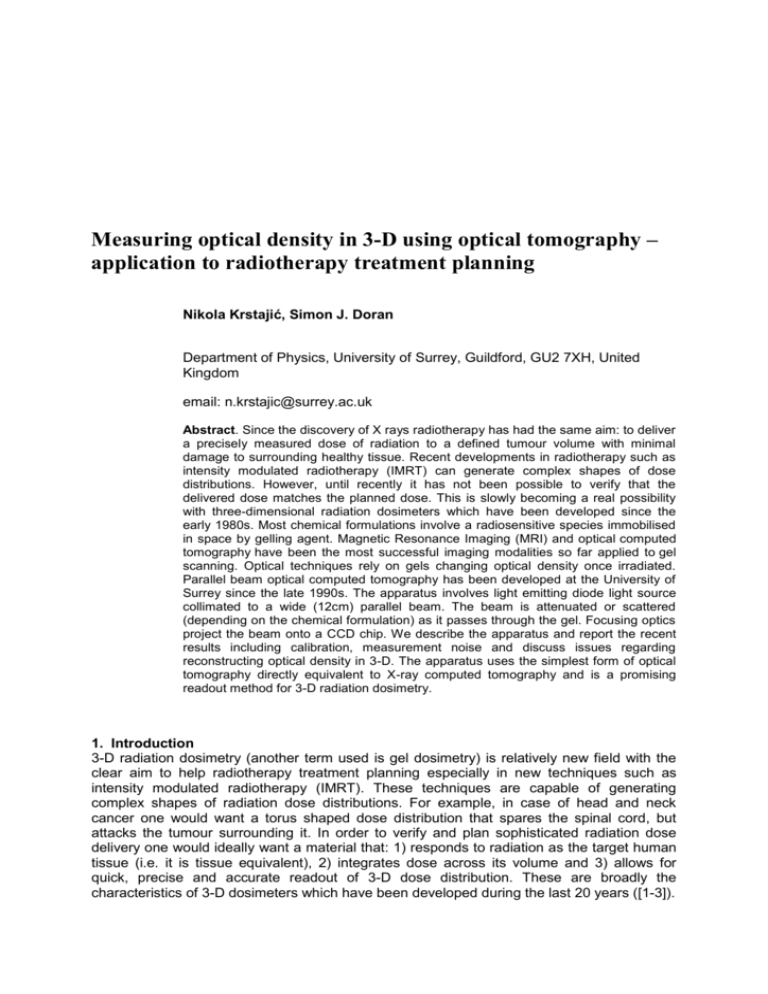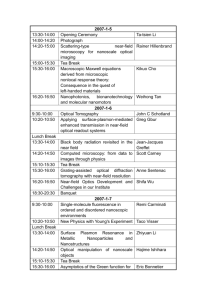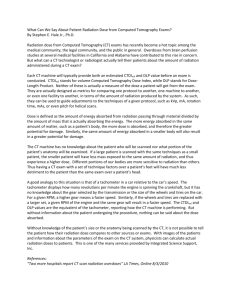Measuring optical density in 3-D using optical tomography
advertisement

Measuring optical density in 3-D using optical tomography – application to radiotherapy treatment planning Nikola Krstajić, Simon J. Doran Department of Physics, University of Surrey, Guildford, GU2 7XH, United Kingdom email: n.krstajic@surrey.ac.uk Abstract. Since the discovery of X rays radiotherapy has had the same aim: to deliver a precisely measured dose of radiation to a defined tumour volume with minimal damage to surrounding healthy tissue. Recent developments in radiotherapy such as intensity modulated radiotherapy (IMRT) can generate complex shapes of dose distributions. However, until recently it has not been possible to verify that the delivered dose matches the planned dose. This is slowly becoming a real possibility with three-dimensional radiation dosimeters which have been developed since the early 1980s. Most chemical formulations involve a radiosensitive species immobilised in space by gelling agent. Magnetic Resonance Imaging (MRI) and optical computed tomography have been the most successful imaging modalities so far applied to gel scanning. Optical techniques rely on gels changing optical density once irradiated. Parallel beam optical computed tomography has been developed at the University of Surrey since the late 1990s. The apparatus involves light emitting diode light source collimated to a wide (12cm) parallel beam. The beam is attenuated or scattered (depending on the chemical formulation) as it passes through the gel. Focusing optics project the beam onto a CCD chip. We describe the apparatus and report the recent results including calibration, measurement noise and discuss issues regarding reconstructing optical density in 3-D. The apparatus uses the simplest form of optical tomography directly equivalent to X-ray computed tomography and is a promising readout method for 3-D radiation dosimetry. 1. Introduction 3-D radiation dosimetry (another term used is gel dosimetry) is relatively new field with the clear aim to help radiotherapy treatment planning especially in new techniques such as intensity modulated radiotherapy (IMRT). These techniques are capable of generating complex shapes of radiation dose distributions. For example, in case of head and neck cancer one would want a torus shaped dose distribution that spares the spinal cord, but attacks the tumour surrounding it. In order to verify and plan sophisticated radiation dose delivery one would ideally want a material that: 1) responds to radiation as the target human tissue (i.e. it is tissue equivalent), 2) integrates dose across its volume and 3) allows for quick, precise and accurate readout of 3-D dose distribution. These are broadly the characteristics of 3-D dosimeters which have been developed during the last 20 years ([1-3]). Although a number of different imaging modalities (magnetic resonance imaging (MRI), optical-CT, X-ray CT and ultrasound) have been suggested for the readout of information from 3-D dosimeters, to date only MRI and laser based optical-CT have been characterized in detail. Reviews of all techniques can be found in the proceedings from recent DOSGEL conferences [4-7]. This abstract describes the initial steps we have taken in establishing CCD based optical-CT as a viable alternative for 3-D radiation dosimetry. The main issue to bear in mind is that 3-D dosimeters are designed so that their optical density (OD) changes linearly with absorbed dose. Therefore, mapping spatial distribution of OD is equivalent to measuring the dose distribution. First, we compare OD measurements from a high quality test target and variable neutral density filter (VNDF). A modulation transfer function (MTF) of individual projections is derived for three positions of the sinusoidal test target within the scanning tank. Our CCD is then characterized in terms of its signal-to-noise ratio (SNR). Finally, a sample reconstruction of a scan of a PRESAGETM 1 dosimeter is given, demonstrating the capabilities of the apparatus. The work presented follows from our previous efforts [8, 9] and parallels similar analysis performed on laser based optical-CT systems [10-12]. 2. Methods A schematic of the apparatus is shown in figure 1(a). The only difference from the description in [8] is the low-noise, air-cooled CCD (Hamamatsu, Orca 1024 BTII, Japan, part C4742-9826KAG). A high quality test target (Edmund Optics, Barrington, NJ, US, part NT54-803) was used for OD and MTF measurement, and a transmission image of the target is shown in figure 1(b). All measurements were made in air (as opposed to the matching liquid) and thus represent a best-case scenario. Prior to saving projections of the test target, a clear light field was obtained. Thus the “true” OD (provided by the target supplier) can be compared with the OD obtained from the light field and the test target projection. The line profile across sinusoidal pattern on the test target projection allows for the MTF to be determined. The square OD steps on the test target are used to investigate projection image quality by obtaining the standard deviation of pixels in the projection. To demonstrate the potential of optical-CT, a PRESAGETM [13] sample was irradiated by 2cm x 2cm, 6MV external photon beam, with SSD 100cm. 3. Results Figure 2(a) demonstrates that with high quality test target and a low noise CCD, linear measurements of the OD are possible directly without the need for calibration curve as in [9], providing the dark noise is taken into account. The VNDF measurement deviates from high quality test target due to VNDF manufacturing tolerances (+/-10%). Figure 2(b) shows the MTF in focus and 100mm away from focus. This suggests that even for large dosimeters, excellent spatial resolution will be possible., The reason for the deviation of the in-focus curve from its theoretical optimum is still under investigation. Figure 2(c) shows how the projection standard deviation (SD) varies with the transmission values. The low values given by triangles represent the low limit obtained by subtracting two successive test target projections. The upper values represented by squares are SD measured across 35x35 pixels region across the OD steps on the test target. Figure 2(d) shows SNR in OD values for the same projection as in 2(c). The best possible SNR is derived by assuming presence of photon and readout noise only. It is not achieved for reasons of optical clarity. Figure 3 shows a slice and profile of the PRESAGETM. 1 PRESAGETM is a registered trademark of Heuris Pharma, NJ, Skillman, USA. a b Figure 1 – (a) shows the outline of the apparatus and (b) the test target used, pixel size 0.2mm. Max possible MTF In focus MTF +100 mm defocus -100mm defocus high quality test target VNDF a b SD measured theoretical minimum SD theoretical maximum SNR SNR measured c d Figure 2 – (a) demonstrates the capability of the CCD to measure OD directly, (b) gives MTF for three positions of the test target. (c) and (d) contrast the best possible performance in terms of SD of projections and SNR in OD with the measured values. SNR is simple ratio, i.e. not in decibels. a b Figure 3 – (a) shows a reconstruction slice of an irradiated PRESAGE TM sample and (b) gives a line profile across the reconstruction over the line indicated in (a). Slice thickness is 1.1mm and the pixel size is 0.38mm x 0.38mm. 4. Discussion The detailed projection analysis is justified since the noise performance of the reconstruction depends solely on noise performance of the individual projections and the number of views [14]. While the CCD technology is maturing [15], there are big developments in CMOS imaging chips with higher dynamic range (via so called “active pixels”), faster scan times and cheaper price [16]. 5. Conclusion High quality and low noise CCDs bring superior performance in OD measurements. They allow measurements with high dynamic range in OD, excellent linearity and low readout noise. The main problem in the context of optical-CT is that the low noise performance is not reached because of optical clarity. 6. Acknowledgments The research was supported by UK EPSRC studentship. NK thanks the Institute of Physics, Optical Physics Group, for generous financial support in attending the Photon06 conference. We wish to thank Dr John Adamovics, Heuris Pharma, Skillman, NJ, USA, for providing the PRESAGETM sample. We wish to thank as well Dr David Bonnett, Medical Physics Department, Maidstone Hospital, Kent Oncology Centre, Maidstone, UK for irradiating the PRESAGETM. References [1] Gore, J.C. and Kang, Y.S., Measurement of radiation dose distributions by nuclear magnetic resonance (NMR) imaging. Physics in Medicine and Biology, 1984. 29(10): p. 1189-1197. [2] Appleby, A. and Leghrouz, A., Imaging of radiation dose by visible color development in ferrous-agarose-xylenol orange gels. Medical Physics, 1991. 18: p. 309-312. [3] De Deene, Y., Essential characteristics of polymer gel dosimeters. Journal of Physics: Conference Series, 2004. 3: p. 34-57. [4] Baldock, C., X-ray computer tomography, ultrasound and vibrational spectroscopic evaluation techniques of polymer gel dosimeters. Journal of Physics: Conference Series, 2004. 3: p. 136-142. [5] [6] [7] [8] [9] [10] [11] [12] [13] [14] [15] [16] De Deene, Y., Fundamentals of MRI measurements in gel dosimetry. Journal of Physics: Conference Series, 2004. 3: p. 87-114. Jordan, K.J., Advances in optical CT scanning for gel dosimetry. Journal of Physics: Conference Series, 2004. 3: p. 115-122. Oldham, M., Optical-CT scanning of polymer gels. Journal of Physics: Conference Series, 2004. 3: p. 293-296. Krstajic, N. and Doran, S.J., Focusing optics of a parallel beam CCD optical tomography apparatus for 3D radiation dosimetry. Physics in Medicine and Biology, 2006. 51: p. 2055-2075. Doran, S.J., et al., A CCD-based optical CT scanner for high-resolution 3D imaging of radiation dose distributions: equipment specifications, optical simulations and preliminary results. Physics in Medicine and Biology, 2001. 46(12): p. 3191-3213. Oldham, M., et al., Optical-CT gel-dosimetry I: basic investigations. Medical Physics, 2003. 30(4): p. 623-634. Oldham, M. and Kim, L., Optical-CT gel-dosimetry II: Optical artifacts and geometrical distortion. Medical Physics, 2004. 31(5): p. 1093-1104. Xu, Y., Wuu, C.-S., and Maryanski, M.J., Performance of a commercial optical CT scanner and polymer gel dosimeters for 3-D dose verification. Medical Physics, 2004. 31(11): p. 3024. Adamovics, J. and Maryanski, M.J., A new approach to radiochromic threedimensional dosimetry-polyurethane. Journal of Physics: Conference Series, 2004. 3: p. 172-175. Gore, J.C., Statistical Limitations in Computer Tomography. Physics in Medicine and Biology, 1978. 23(6): p. 1176-1182. Janesick, J. and Putnam, G., Developments and applications of high-performance CCD and CMOS imaging arrays. Annual Review of Nuclear and Particle Science, 2003. 53: p. 263-300. Turchettaa, R., et al., CMOS: Monolithic Active Pixel Sensors (MAPS): New ‘eyes’ for science. Nuclear Instruments and Methods in Physics Research Section A: Accelerators, Spectrometers, Detectors and Associated Equipment, 2006. 560(1): p. 139-142.







